You are using an out of date browser. It may not display this or other websites correctly.
You should upgrade or use an alternative browser.
You should upgrade or use an alternative browser.
Neck turning & annealing question
- Thread starter loaders_loft
- Start date
 Help Support Long Range Hunting Forum
Help Support Long Range Hunting Forum
Not high self confidence, just a bad experience...I did say it was a little harsh! I also love the little hot-100, but I find the plastic case holder a disaster. It's tightening knob bites into the fingers harshly after 100 rouds and it is very hard to get tight and if not perfectly tight on an appropriately fitted mandrel (snug) it turns the cases and scratches the hell out of it. For my money, the sinclair case driver made life a lot easier with better results. Smoother finish.
boomtube
Well-Known Member
We can all do as we wish, and say what we wish for what ever reasons that seem good to us, that's a given. I just question the wisdom of making such judgements about those who may be disinclined to agree with us.
Saying it they way you did, then recognising it in the same sentence but allowing it to stand suggests more judgemental self confidence than I can muster even after well over 4 decades of reloading.
Your turning position is clearly valid, for you, and as you state it. We may type harsh things light hearted but people simply read the words as they are written.
Perhaps writting our views and supporting logic without the name calling and judgements might be more rational. ??
Saying it they way you did, then recognising it in the same sentence but allowing it to stand suggests more judgemental self confidence than I can muster even after well over 4 decades of reloading.
Your turning position is clearly valid, for you, and as you state it. We may type harsh things light hearted but people simply read the words as they are written.
Perhaps writting our views and supporting logic without the name calling and judgements might be more rational. ??
It was all written light heartedly. Moron is clearly the wrong word. Apologies if your offended. It is tough to communicate when you can't read body language etc. Not making any judgements. If it aint broke, dont fix it. Seriously, do you use the plastic hand turner for 100 plus rounds? Seems a bit sadistic, but maybe you are tougher than me! If you have been reloading for 40 plus years, maybe you are retired and have more time? I did however, write my view, supported it with logic, references included for further reading/research.
We seem to have similiar opinions on core issues, but wording gets in the way!
We seem to have similiar opinions on core issues, but wording gets in the way!
woods
Well-Known Member
Well, personally I've been married so long that one sentence with "moron" in it didn't even break the surface.
Call me crazy, but I kinda look forward to neck turning new cases. It does take some time but it is not something that needs total attention like powder charging cases. Just set it up and watch a movie while doing it. The plastic shell holder works better for me if I take a small pair of pliers on the knob and tighten it down good onto the case head. Kinda boogers up the knob but it is still there after several hundred cases.
I like to turn by hand because I can feel the amount of resistance and know when I have made a smooth cut all the way. Most of the turning I have to do is for tight neck custom chambers and some of the brass has to go from .015"+ to .0125" which is a lot of brass coming off. I tried locking the case in a Zip Trim and turning but it would chatter a little and stress the whole process more. Turning slowly by hand will keep you out of trouble.
One advantage of the Forster is that they have neck reamers that have the same size lock stud
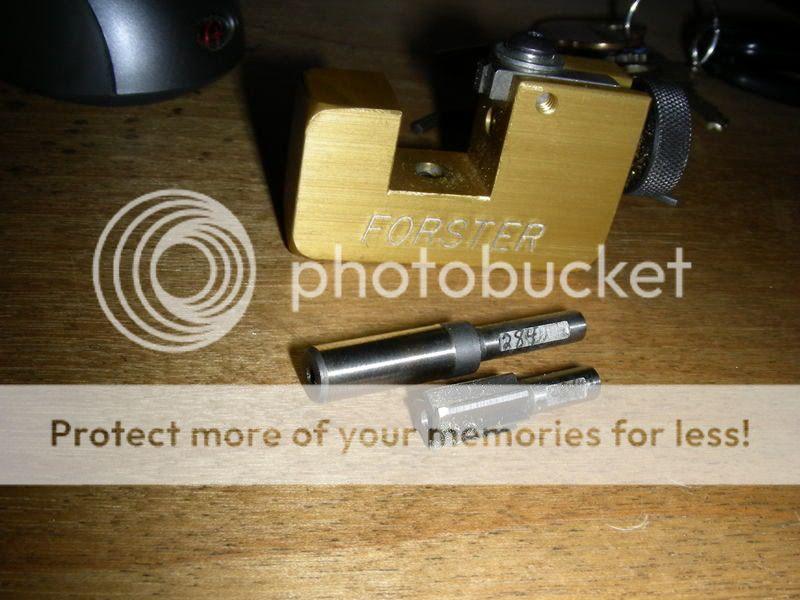
the neck reaming mandrels are .003" over caliber so if you set your neck clearance up at .003" then after firing the reamers fit right in. That will get rid of any do-nuts or inconsistancies at the neck/shoulder junction. You can also inside neck ream and outside neck turn at the same time to clean up the outside one last time
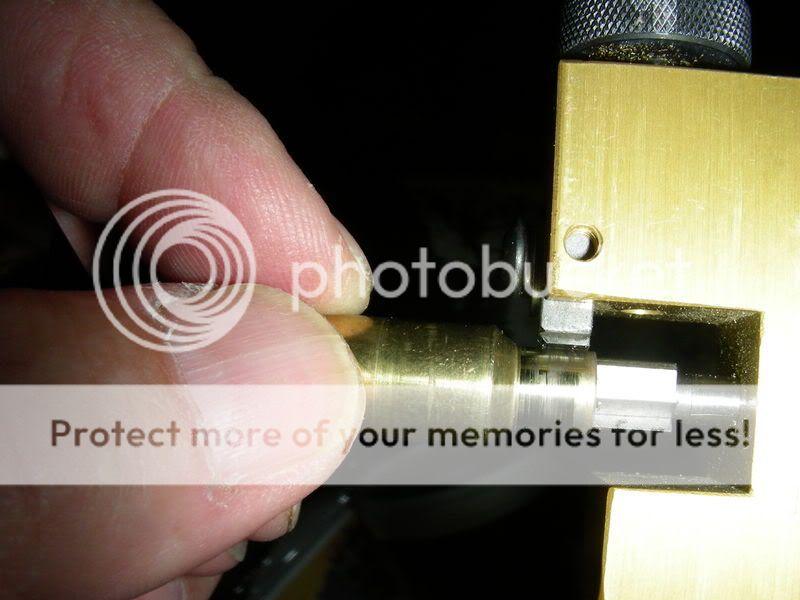
On this case, reaming and cleaning up the outside took the neck thickness from .0125"
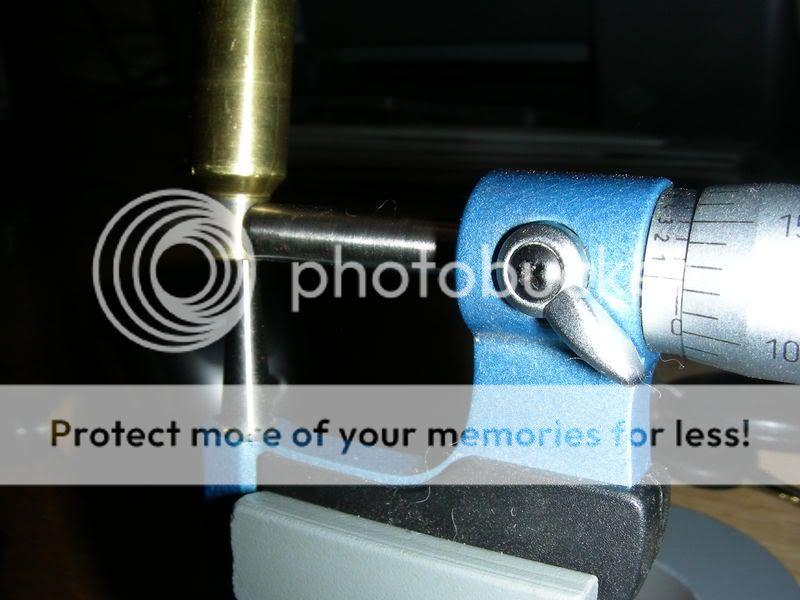
to a very consistant .012"
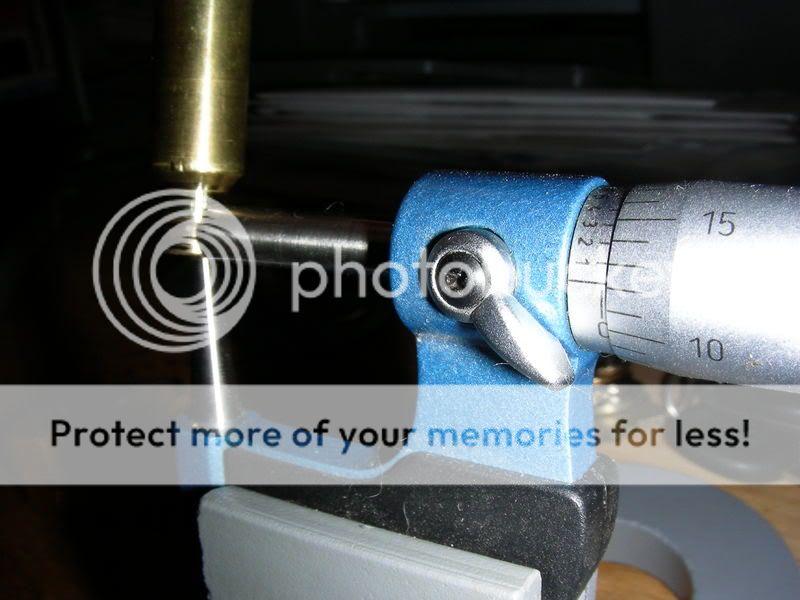
The most detrimental effect of outside turning or reamins is that it boogers up the inside neck surface pretty bad
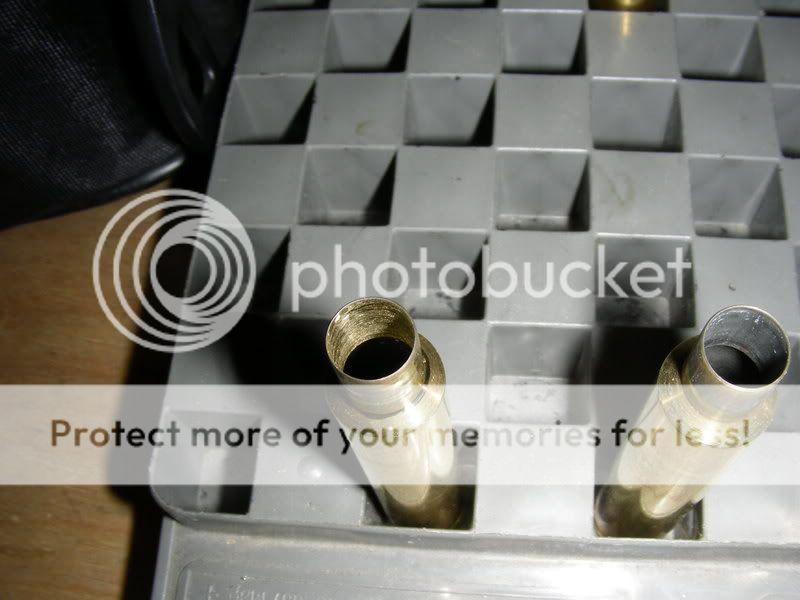
so I clean them up with some tight fitting steel wool on a 22 caliber brush
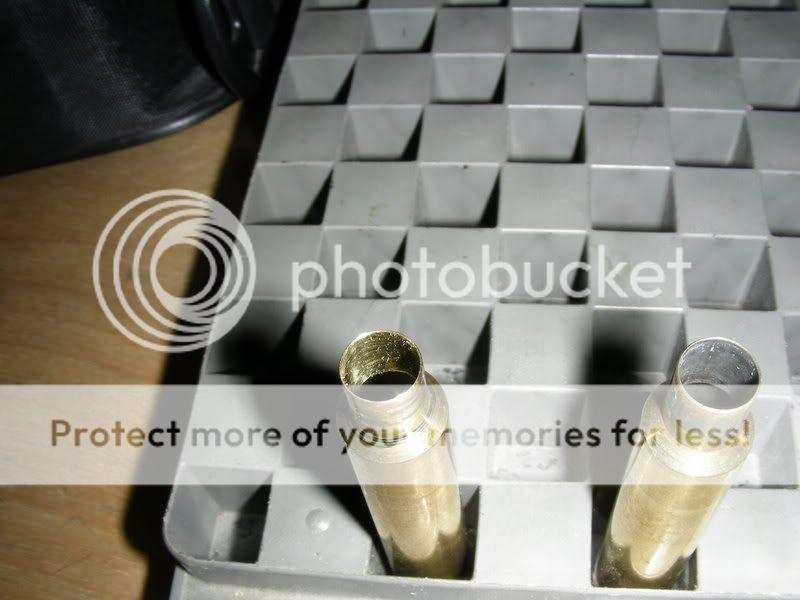
to make them somewhat smoother. Trying to figure out a way to get some Flitz appied to that inside surface and polish them.
Call me crazy, but I kinda look forward to neck turning new cases. It does take some time but it is not something that needs total attention like powder charging cases. Just set it up and watch a movie while doing it. The plastic shell holder works better for me if I take a small pair of pliers on the knob and tighten it down good onto the case head. Kinda boogers up the knob but it is still there after several hundred cases.
I like to turn by hand because I can feel the amount of resistance and know when I have made a smooth cut all the way. Most of the turning I have to do is for tight neck custom chambers and some of the brass has to go from .015"+ to .0125" which is a lot of brass coming off. I tried locking the case in a Zip Trim and turning but it would chatter a little and stress the whole process more. Turning slowly by hand will keep you out of trouble.
One advantage of the Forster is that they have neck reamers that have the same size lock stud

the neck reaming mandrels are .003" over caliber so if you set your neck clearance up at .003" then after firing the reamers fit right in. That will get rid of any do-nuts or inconsistancies at the neck/shoulder junction. You can also inside neck ream and outside neck turn at the same time to clean up the outside one last time

On this case, reaming and cleaning up the outside took the neck thickness from .0125"

to a very consistant .012"

The most detrimental effect of outside turning or reamins is that it boogers up the inside neck surface pretty bad

so I clean them up with some tight fitting steel wool on a 22 caliber brush

to make them somewhat smoother. Trying to figure out a way to get some Flitz appied to that inside surface and polish them.
Nice post Woods. the chatter from hand turning just drives me nuts. I tried the whole pliers thing and I just didn't like putting that much unilateral pressure on my cases. I maintain that power driving is easier and smoother, with the added benefit of inside chamfer (if you desire), outside deburr, and polish w/ steel wool all while in the case driver. If I take off that much brass, I just do it in steps. Best logic for hand turning yet.. backed up with pics!
I guess if my humor is to come through I need to end each sentence with a green smiley or something so no one is offended!
I guess if my humor is to come through I need to end each sentence with a green smiley or something so no one is offended!
boomtube
Well-Known Member
"I guess if my humor is to come through I need to end each sentence with a green smiley or something so no one is offended!"
You misunderstand ME! I'm by no means offended. I simply thought your language, which you did recognise as inapporpreate, was not supportive to your efforts. Speak any way you like as far as I'm concerned, I didn't ask the question you responded to.
I do agree with Woods, using a Forster neck reamer to make a smoother interior surface works. But I only use a reamer when reforming cases and the neck is far thicker than it need be for a snug fit in my chamber.
With a good lube on the mandral and in the neck I've never had any chatter. I don't use a lot of feeding pressure on my hand held turner tho, knowing it would build up heat and expand the brass which would negate the precise fit and subsequent turning I seek.
Retired or not, precision reloading and case preperation is not something to be done in a hurry. What I don't get done today, I will get done next time. Or the next.
You misunderstand ME! I'm by no means offended. I simply thought your language, which you did recognise as inapporpreate, was not supportive to your efforts. Speak any way you like as far as I'm concerned, I didn't ask the question you responded to.
I do agree with Woods, using a Forster neck reamer to make a smoother interior surface works. But I only use a reamer when reforming cases and the neck is far thicker than it need be for a snug fit in my chamber.
With a good lube on the mandral and in the neck I've never had any chatter. I don't use a lot of feeding pressure on my hand held turner tho, knowing it would build up heat and expand the brass which would negate the precise fit and subsequent turning I seek.
Retired or not, precision reloading and case preperation is not something to be done in a hurry. What I don't get done today, I will get done next time. Or the next.
Didn't mean to single anybody out, but I do see a lot of green smiley's etc!.
I do need some help regarding neck turning and would thoroughy appreciate some input from all of you (boomtube, woods etc). Since it is a new question, I will start it in a new thread.
Maybe in asking my question we can also help loaders loft (the guy that asked the original question) know when to neck turn!
I do need some help regarding neck turning and would thoroughy appreciate some input from all of you (boomtube, woods etc). Since it is a new question, I will start it in a new thread.
Maybe in asking my question we can also help loaders loft (the guy that asked the original question) know when to neck turn!
woods
Well-Known Member
Didn't mean to single anybody out, but I do see a lot of green smiley's etc!.
I do need some help regarding neck turning and would thoroughy appreciate some input from all of you (boomtube, woods etc). Since it is a new question, I will start it in a new thread.
Maybe in asking my question we can also help loaders loft (the guy that asked the original question) know when to neck turn!
Where's the new thread?
Turn the necks on new cases.
Ackley Man
Well-Known Member
Bounty Hunter and Buffalo Bob are dead on. The only thing that you should do by turning the necks when using a standard SAMI spec chamber is to shave off the high spots on the necks which really will not impact accuracy enough to go through the effort. If you don't have a tight neck chamber forget the neck turning as you will only ruin several pieces of brass during a learning process that will not accomplish anything for you. If you really want to get into the tight neck chamber aspect, which does requires neck turning, you will need your gun re-barreled. However, if you intend to use it for standard hunting a tight neck chamber is not they way to go as a couple of grains of sand can prevent chambering of a round because you should only have 1 1/2 to 2 thousands of clearance per side between the neck brass and the chamber neck. Worse yet you could end up with a stuck case. Even worse yet the stuck case could be a loaded round! Take the neck turning tool back and exchange it for a concentricity gauge and start checking your bullet run-out. That is something that will help your accuracy in a standard chamber.
No matter when you wish to turn necks, first you must open the necks to the same diameter using a caliber specific expander. With virgin brass, this may not be necessary if they slide easily thru the expander. For a factory chamber, you want to skim turn the necks only, stopping right at the neck-shoulder junction. This means you will just barely touch the necks. do not cut down so that the entire neck is bright shiny brass. I anneal after every five firirings for competition cases, as that is when the brass starts to get brittle. I do not anneal hunting brass; replace it when the first case shows a small crack.
I have ordered an outside neck turning tool for my 7 wsm brass. I've seen from multiple sources that the uniformity of this brass can greatly benefit from neck turning.
Before I screw up any brass, I've got a few questions.
When is the best time to turn the necks - after FL resizing brand new brass, or after partial FL resizing once fired brass? I've got 100 pcs of brand new brass that needs to be prepped. I'm thinking, right after FL resizing, before any other prep work.
Also, is there any benefit to neck turning my previously fired brass I've been shooting (mulitple reloads), or is it too late for that now?
How close to the neck-shoulder interface should I turn the necks?
My normal process on fired 7 wsm brass is:
tumble
partial FL resize, no bump (simultaneously deprime)
wipe off case lube
measure oal and check proper chambering
trim all alike if required on any
if trimmed, ID/OD chamfer & steel wool polish mouth (Thanks Varmint Al)
primer pocket brush
neck brush
prime
load powder, seat & check proper chambering
lightbulbAlong the same lines, - when in this process is the best time to anneal my previously fired brass? I'm thinking, right after tumbling, with a repeat tumbling after annealing. Please advise.
Thanks in advance!
L_L